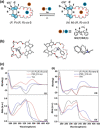Motorized Macrocycle: A Photo-responsive Host with Switchable and Stereoselective Guest Recognition
- PMID: 33955650
- PMCID: PMC8361693
- DOI: 10.1002/anie.202104285
Motorized Macrocycle: A Photo-responsive Host with Switchable and Stereoselective Guest Recognition
Abstract
Designing photo-responsive host-guest systems can provide versatile supramolecular tools for constructing smart systems and materials. We designed photo-responsive macrocyclic hosts, modulated by light-driven molecular rotary motors enabling switchable chiral guest recognition. The intramolecular cyclization of the two arms of a first-generation molecular motor with flexible oligoethylene glycol chains of different lengths resulted in crown-ether-like macrocycles with intrinsic motor function. The octaethylene glycol linkage enables the successful unidirectional rotation of molecular motors, simultaneously allowing the 1:1 host-guest interaction with ammonium salt guests. The binding affinity and stereoselectivity of the motorized macrocycle can be reversibly modulated, owing to the multi-state light-driven switching of geometry and helicity of the molecular motors. This approach provides an attractive strategy to construct stimuli-responsive host-guest systems and dynamic materials.
Keywords: capture and release; host-guest interactions; motorized macrocycles; photo-responsiveness; stereoselectivity.
© 2021 The Authors. Angewandte Chemie International Edition published by Wiley-VCH GmbH.
Conflict of interest statement
The authors declare no conflict of interest.
Figures





Similar articles
-
Stimuli-responsive host-guest systems based on the recognition of cryptands by organic guests.Acc Chem Res. 2014 Jul 15;47(7):1995-2005. doi: 10.1021/ar500046r. Epub 2014 May 8. Acc Chem Res. 2014. PMID: 24804805
-
Aromatic amide and hydrazide foldamer-based responsive host-guest systems.Acc Chem Res. 2014 Jul 15;47(7):1961-70. doi: 10.1021/ar5000242. Epub 2014 Mar 27. Acc Chem Res. 2014. PMID: 24673152
-
Motorized Photomodulator: Making A Non-photoresponsive Supramolecular Gel Switchable by Light.Angew Chem Int Ed Engl. 2023 Oct 23;62(43):e202310582. doi: 10.1002/anie.202310582. Epub 2023 Sep 19. Angew Chem Int Ed Engl. 2023. PMID: 37681477
-
Light-responsive nanochannels based on the supramolecular host-guest system.Front Chem. 2022 Sep 21;10:986908. doi: 10.3389/fchem.2022.986908. eCollection 2022. Front Chem. 2022. PMID: 36212057 Free PMC article. Review.
-
Fluorescent Supramolecular Polymers Formed by Crown Ether-Based Host-Guest Interaction.Front Chem. 2020 Jul 24;8:560. doi: 10.3389/fchem.2020.00560. eCollection 2020. Front Chem. 2020. PMID: 32793552 Free PMC article. Review.
Cited by
-
Photoswitchable molecular tweezers: isomerization to control substrate binding, and what about vice versa?Chem Commun (Camb). 2022 Oct 4;58(79):11045-11058. doi: 10.1039/d2cc04329g. Chem Commun (Camb). 2022. PMID: 36106956 Free PMC article. Review.
-
Enlightening dynamic functions in molecular systems by intrinsically chiral light-driven molecular motors.Chem Soc Rev. 2023 Aug 29;52(17):5875-5891. doi: 10.1039/d3cs00247k. Chem Soc Rev. 2023. PMID: 37581608 Free PMC article. Review.
-
Dynamic control of circumrotation of a [2]catenane by acid-base switching.ChemistryOpen. 2024 Aug;13(8):e202300304. doi: 10.1002/open.202300304. Epub 2024 Feb 9. ChemistryOpen. 2024. PMID: 38333963 Free PMC article.
-
Synthesis of Large Macrocycles with Chiral Sulfur Centers via Enantiospecific SuFEx and SuPhenEx Click Reactions.J Org Chem. 2023 Nov 17;88(22):15658-15665. doi: 10.1021/acs.joc.3c01656. Epub 2023 Oct 30. J Org Chem. 2023. PMID: 37903243 Free PMC article.
-
A photochemical method to evidence directional molecular motions.Nat Commun. 2023 Jul 31;14(1):4595. doi: 10.1038/s41467-023-40190-4. Nat Commun. 2023. PMID: 37524701 Free PMC article.
References
-
- None
-
- Cram D. J., Angew. Chem. Int. Ed. Engl. 1988, 27, 1009–1020;
- Angew. Chem. 1988, 100, 1041–1052;
-
- Lehn J.-M., Angew. Chem. Int. Ed. Engl. 1988, 27, 89–112;
- Angew. Chem. 1988, 100, 91–116;
-
- Pedersen C. J., Angew. Chem. Int. Ed. Engl. 1988, 27, 1021–1027;
- Angew. Chem. 1988, 100, 1053–1059.
-
- None
Publication types
LinkOut - more resources
Full Text Sources
Other Literature Sources

